The Impact of Glass Doors on Modern Interior Design
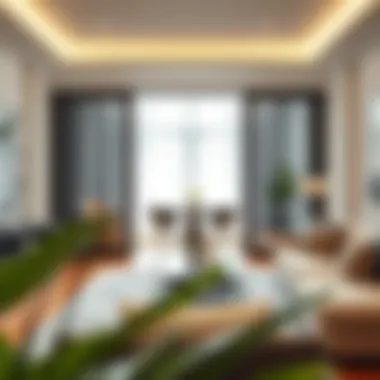
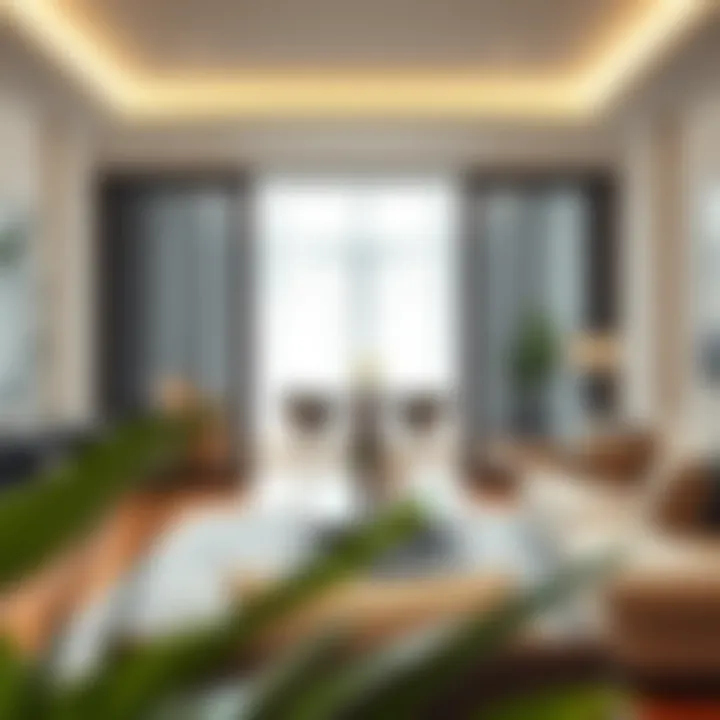
Intro
In the ever-evolving world of interior design, glass doors have emerged as a critical element that intertwines aesthetics and functionality. They serve not just as entry points but also as showcase features that draw attention to the beauty of the decor and furniture within a space. This article will peel back the layers of how glass doors can redefine modern interiors, proving that their role extends beyond mere separation of spaces. Understanding their significance in showcasing furniture and artwork is essential for anyone involved in enhancing living spaces—be it interior designers, decorators, or homeowners.
Furniture Design Trends
When looking at the modern design landscape, some themes emerge that are reshaping the way furniture is presented and chosen in tandem with glass doors. The interplay of simplicity and elegance often defines current trends. Here are some pivotal trends:
Current Trends in Furniture Design
- Minimalism: Less is often more. Sleek, streamlined furniture that doesn't overpower the space is gaining traction. Glass doors complement this trend by allowing visibility without obstruction, creating a sense of openness.
- Mixed Materials: Combining various materials has become popular. Think wooden frames with glass inserts or metal fixtures alongside soft textiles. This gives a layered look and allows glass doors to enhance the overall design.
- Sustainable Choices: Homeowners today are more conscious of their selections. Furniture made from reclaimed wood or recycled materials is more appealing. Glass interacts beautifully with these materials, reflecting light and making spaces feel eco-friendly and fresh.
Influential Designers to Follow
Certain designers have been at the forefront of these trends, often showcasing innovative uses of glass doors in their projects.
- Jonathan Adler: Known for his vibrant colors and unique textures, his designs incorporate glass elements brilliantly.
- Kelly Wearstler: A master of mixing patterns and materials, her spaces frequently feature clear glass to create visual intrigue while maintaining fluidity between rooms.
Practical Tips for Furniture Selection
Selecting the right furniture to harmonize with glass doors can make or break the aesthetic of a home. Here are some practical considerations:
Choosing the Right Materials
When it comes to furniture selection, the materials used can significantly elevate the aesthetics of your space. Explore options like:
- Acrylic and Glass: For a modern vibe, these materials can create a seamless look, allowing light to flow freely.
- Natural Fibers: If your style leans towards Bohemian or organic, rattan or jute pieces can soften the sharpness of glass elements.
Maximizing Space with Smart Furniture Choices
Functionality meets design when furniture serves dual purposes. Here are some strategies:
- Multi-functional Pieces: Consider items like storage ottomans or extendable dining tables. They save space while providing utility.
- Transparent Furniture: Items such as clear side tables or chairs can blend without creating visual clutter, enhancing the openness provided by glass doors.
"The clever use of glass doors can illuminate a space and highlight the beauty of what lies beyond them."
In summary, the integration of glass doors in modern interiors is not just about style, it's about creating functional and inviting spaces that showcase the character of your home. Whether it’s choosing the right furniture or understanding contemporary design trends, discerning homeowners can make informed decisions that elevate their environments.
Understanding the Concept of Showcase Designs
Showcase designs are an essential element in modern interiors, elevating both functionality and aesthetics in a way that other materials often cannot achieve. The idea here is to create spaces that not only serve their primary purposes but also exhibit the beauty and character of the items they hold. These designs play a pivotal role in how we perceive our environments. They bring an air of sophistication and openness that seems to welcome anyone who steps inside.
Defining Showcase Element in Interiors
The showcase element in interiors generally refers to structures or features specifically designed to display items. This can range from simple shelves to elaborate glass display cabinets. When we talk about showcasing, we often emphasize transparent materials like glass because they create an illusion of continuity between different spaces. These designs can effectively highlight art pieces or decor items while protecting them from dust or damage. In modern home designs, the showcase aspect isn’t just about function—it’s about crafting a narrative.
When people enter a room, what they see at first glance can speak volumes about the inhabitants. A carefully curated display can offer insights into personal passions or style. Instead of cluttered spaces filled with assorted objects, a well-planned showcase allows for meaningful curation, celebrating not only the items themselves but also the intention behind them.
Importance of Visual Appeal
The visual appeal of an interior setting cannot be overstated. Showcasing items behind glass doors or in open shelves alters how light plays with surfaces, which can drastically change the atmosphere of a room. Light filtering through transparent materials creates an elegant effect that more opaque structures simply can’t replicate. The insight that a well-designed showcase offers can turn a room’s ambiance from ordinary to extraordinary.
Additionally, visual appeal also contributes to perceptions of space. In smaller rooms, the use of glass showcases can create a sense of openness, making the area feel larger than it is. When items are displayed with the right balance of light and shadow, they stand out, inviting the viewer's eye. Thus, it is imperative for interior designers and homeowners to invest thought and consideration into how and where these elements will be placed.
"Showcasing isn't just about displaying items—it's an art that narrates a story, infusing life into the spaces we inhabit."
To sum up, understanding the showcase designs is crucial for anyone looking to enhance their living spaces. With the right approach, these elements can not only add beauty and appeal but also foster a deeper connection between the occupant and their environment. This blend of form and function makes showcase designs a worthy focus in contemporary interior styling.
Glass Doors: A Modern Solution
In today's interior design realm, glass doors have carved a niche for themselves, merging style and practicality in ways that resonate with modern sensibilities. Their ubiquitous presence speaks volumes about their significance in enhancing both residential and commercial spaces. Glass doors stand at the intersection of aesthetics and functionality, offering solutions that go beyond mere entry points. They invite light, visibility, and a seamless transition between spaces, making them a considerable choice for contemporary design.
When homeowners, architects, or designers ponder about modern materials, glass is at the forefront, not just for its visual appeal but also for its versatile applications. The beauty of these installations goes hand in hand with their efficiency in creating an open feel while maintaining necessary boundaries. This dual nature elevates them from simple architectural features to pivotal elements in interior design.
The Versatility of Glass Door Designs
Glass doors offer an impressive range of designs that cater to various tastes and functional needs. They can easily adapt to different architectural styles—be it minimalistic, rustic, or contemporary. Homeowners might find it perplexing to narrow down their options, as each type brings something unique to the table.
One of the key advantages of glass doors is their ability to enhance views and create a sense of openness. Unlike solid doors, the transparency allows natural light to cascade through, illuminating the interiors. Moreover, designs can vary from sleek and functional to ornate and decorative, which ensures a perfect fit in every environment.
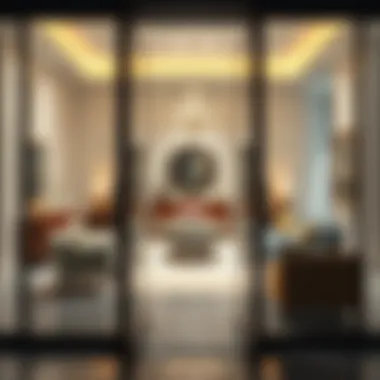

With the demand for sustainability on the rise, glass doors can also support energy-efficient solutions by incorporating thermally insulated glass, ultimately leading to lower energy bills. This isn’t just a trend; it’s an important consideration when selecting materials for modern homes.
Types of Glass Doors Available
Sliding Glass Doors
Sliding glass doors are practically the champions of space-saving solutions. Their unique mechanism allows panels to glide smoothly along a track, which is a game changer for small spaces. One remarkable feature of sliding doors is that they open up an entire wall, effortlessly merging indoor and outdoor environments. This closing off and opening up fosters a heightened sense of connectivity with nature.
Many homeowners lean towards sliding glass doors because they provide a wide view while keeping the elements at bay. However, they might not be suitable for every layout, as their hardware requires careful installation and maintenance to function properly. If installed correctly, sliding glass doors can serve as a stylish and practical focal point in the home.
French Glass Doors
French glass doors bring a certain elegance that few other designs can replicate. They often come divided into multiple panes, and this traditional aesthetics appeals to many who appreciate charm. Not only do these doors offer a touch of class, but they can also create a sophisticated entry or exit point between rooms or out to a patio.
The beauty of French doors lies in their ability to allow light to pour in while still delineating separate spaces. However, they often require more space to swing open than sliding options, making their placement critical. It’s a balancing act between function and style, and for many, the classic appeal outweighs the practical considerations.
Bi-Fold Glass Doors
Bi-fold glass doors are a modern marvel, capable of transforming spaces with their innovative design. They consist of several panels that fold back against themselves, providing an expansive opening that can bridge indoor and outdoor spaces seamlessly. This flexibility is particularly useful for those who love entertaining, as bi-fold doors can create an expansive area perfect for gatherings.
From a design perspective, bi-fold doors can fit a wide array of styles, thanks to customizable configurations. They stand out as a popular choice due to their ability to create an unobstructed view when fully opened. However, like sliding doors, they do require proper installation, which can complicate their placement.
In summary, the type of glass door selection plays an essential role in redefining the character of interior spaces while highlighting the individual’s taste. Each type comes with its unique features and considerations, ensuring that anyone can find the perfect fit to harmonize with their vision of a modern interior.
Aesthetic Benefits of Glass Doors
The aesthetic advantages of utilizing glass doors in modern interiors can’t be overstated. They serve as more than just barriers; they become striking features that can reshape a room’s atmosphere. It’s about how they can harmonize with the environment to create an inviting and spacious feel, pushing the boundaries of tradition in home design.
Creating an Illusion of Space
One of the standout perks of glass doors is their remarkable ability to create an illusion of space. With solid walls, a room can often feel quite cramped, but glass brings a breath of fresh air. It allows for seamless transitions between spaces—taking a room that might seem small and giving it depth. You could easily find that a room can feel much larger just by replacing a traditional door with a glass one.
Moreover, considering how light travels, glass doors can reflect images and colors from the adjacent areas. This interaction can soften harsh angles and make a fixed space feel fluid. It’s akin to giving the walls a chance to breath, letting light and visual continuity define boundaries instead of solid structures. For instance, a bi-fold glass door can open up like a book, pulling the garden into your living space. It often encourages the feeling that indoor activities are not confined.
"A glass door is like a window that opens wide without a frame, inviting not just light, but life into a home."
Enhancing Natural Light
Natural light does wonders for both mood and design, and glass doors excel at maximizing this precious resource. In modern interiors, a design that blends functionality with aesthetic appeal is the golden ticket. Glass doors act as conduits for sunlight, bathing spaces in warmth and brightness throughout the day. This not only reduces reliance on artificial lighting, which can be a drain on energy costs, but also enhances the colors and textures within a room.
With various designs, like French or sliding glass doors, one can customize how much light enters without compromising privacy. For example, frosted glass options still permit ample luminosity but obscure the view, striking a balance that works well for bathrooms or bedrooms.
Incorporating glass doors doesn’t just brighten up a space; it creates a lively ambiance that contributes positively to one's well-being. A home filled with natural light feels more inviting, energetic, and alive. After all, who wouldn’t want to feel cheered up by sunlight streaming through their doors?
In summary, the aesthetic benefits of glass doors extend far beyond mere looks. They transform the way we perceive spaces, promoting a bright and airy feel that appeals to both the senses and the soul, making them an exceptional choice in contemporary home design.
Functional Advantages of Showcasing with Glass
Glass doors present a plethora of functional advantages that can significantly enhance the livability and functionality of modern interiors. Whether in residential spaces or commercial environments, the act of showcasing items behind glass serves not only an aesthetic purpose but amplifies practicality in various compelling ways. Below, we delve into two pivotal advantages that highlight why glass doors are favored choices in modern design.
Easy Visibility of Items
One of the foremost advantages of glass doors is the ease with which items can be viewed. Picture a stylish display cabinet adorned with your favorite collectibles or a vibrant assortment of books. With glass doors, these are not just hidden treasures behind opaque fronts; they create a striking visual display that instantly captures attention. Homeowners can effortlessly showcase their personal style and creativity without needing to constantly rearrange or expose everything to the elements.
The clarity that glass provides allows for a simultaneous display and protection of items, which is particularly useful in areas where both accessibility and presentation are paramount. Imagine organizing a collection of fine wines or artisanal pottery in a dining area. With an elegant glass enclosure, guests can marvel at the vibrant colors and shapes while you maintain an organized, clutter-free environment.
Moreover, this visibility fosters a sense of openness in a space, allowing light to flow and enhancing an overall feeling of spaciousness. In rooms that may feel cramped or dark, glass doors can create a seamless transition, making the environment feel inviting and airy.
Protecting Valuables from Dust
Another compelling advantage of incorporating glass in your interior design is the protection it provides for valuable items from dust and dirt. Unlike traditional shelving or cabinets that may require regular cleaning and upkeep, glass doors essentially form a barrier, safeguarding cherished possessions from everyday elements that can lead to discoloration and degradation over time.
For example, if you house your grandmother’s antique china or a carefully curated art collection, a glass enclosure ensures they remain pristine. It eliminates the need for constant polishing and care while allowing your treasures to remain visible and admired. This is especially advantageous in open-concept spaces or high-traffic areas where dust tends to settle.
Furthermore, with various types of contemporary glass doors available—such as tempered glass or low-maintenance, easy-to-clean options—protecting your valuables has never been simpler. Homeowners can enjoy peace of mind knowing their prized possessions are safe yet still on display.
"Incorporating glass doors in your interior isn’t just about looks; it’s about merging function and style seamlessly."
For these reasons, the functional advantages of showcasing items with glass doors can make a significant impact on the overall user experience in any space. When thoughtfully considered, it not only enhances the aesthetic but also ensures longevity and practicality, providing a holistic approach to modern interior design.
Design Considerations for Glass Doors
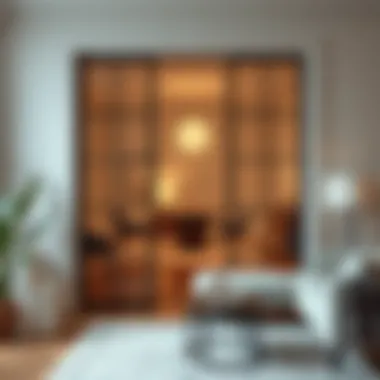
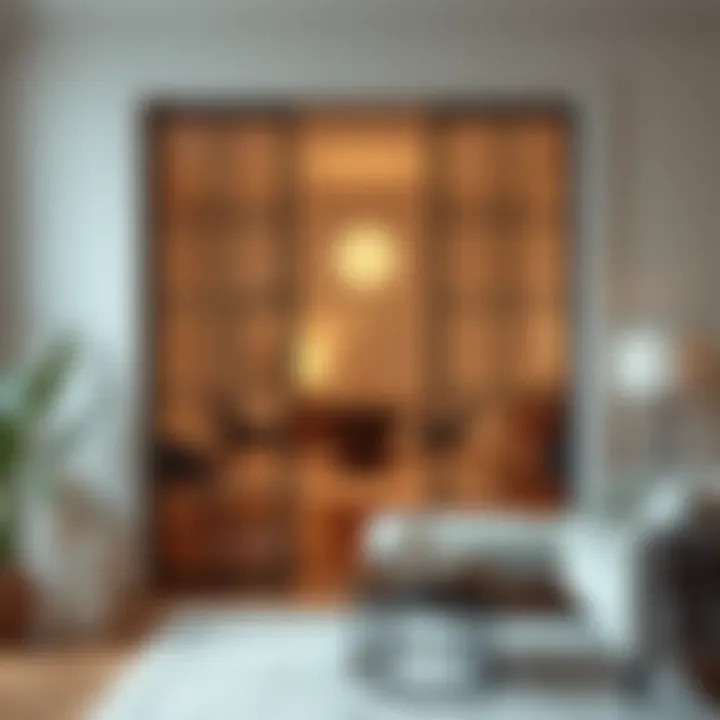
When it comes to incorporating glass doors into modern interiors, design considerations play a vital role. Not just a portal between rooms, glass doors can utterly transform a space, serving both aesthetic and functional purposes. Choosing the right design elements can make a significant difference in how a room is perceived and utilized. Let's dive into what homeowners and designers need to consider carefully.
Framing Options: Materials and Styles
The framing of glass doors isn't merely an afterthought. The materials and styles chosen can enhance the overall aesthetic and functionality of the door itself. Popular materials include:
- Wood: This material can introduce a warm, inviting feeling, particularly when painted or stained to match existing decor. A wooden frame can also provide a rustic charm or modern elegance, depending on the finish.
- Aluminum: Durable and lightweight, aluminum frames have an industrial vibe that suits contemporary and minimalist designs. They come in various colors and finishes which can complement any interior style.
- Vinyl: This option provides excellent insulation while being low-maintenance. Ideal for budget-conscious homeowners, vinyl frames can be found in numerous colors and textures, adding versatility to the look.
- Steel: Particularly suited for lofts or urban environments, steel frames offer a sleek, modern appeal. Their durability ensures that these doors can withstand heavy use without compromising style.
Various styles also influence the character of a glass door:
- Frameless doors create a seamless transition between spaces, emphasizing openness and a modern aesthetic.
- Mullioned glass doors, featuring grid patterns, can introduce a more traditional feel, often seen in country or cottage-style homes.
Choosing the right material and style is about striking a balance between beauty and practicality. A well-chosen frame can not only elevate the visual appeal but also enhance the door's performance concerning insulation and security.
Choosing the Right Placement
Placement of glass doors has a tremendous impact on the way spaces function and feel. An ill-placed door can disrupt the flow, while strategic placement can magnify the advantages of natural light and visual connectivity. Here are some key points to think about:
- Entry Points: Consider where most foot traffic occurs, and position glass doors to streamline movement between spaces. For example, a sliding glass door leading to a patio can create an inviting transition between indoor and outdoor living, allowing for a seamless flow during social gatherings.
- Views and Light: Positioning glass doors to frame attractive views can maximize aesthetic appeal. When a door offers a picture-perfect sight of the garden or cityscape, it becomes more than just functional; it becomes a focal point.
- Privacy Considerations: While glass doors enhance light, privacy can be a concern. Strategically placing frosted or tinted glass doors allows light to come in while preventing outsiders from looking in, thereby maintaining comfort and confidentiality.
- Room Connection: Glass doors can bridge formal and informal spaces effectively. Placing them between a dining area and a living room, for instance, can foster connectivity without the feeling of enclosed spaces.
Placing glass doors requires thoughtful planning, balancing aesthetics with practical needs to create a harmonious home environment.
It's essential to take time to reflect on both the materials used in framing and the placement of glass doors. These families should fit within the overall design narrative of the home, yielding not only functionality but enhancing ambience and style, too.
Integration with Existing Decor
Integrating glass doors into your home design is not just about aesthetics; it's a delicate dance with your existing decor. When choosing glass doors, understanding how they complement your current setup plays a crucial role in creating a cohesive look. Homeowners often underestimate the impact of this harmonization on their overall space. The thoughtful blending of styles can elevate a room from ordinary to extraordinary, and it’s not merely about matching colors—it's about evoking an atmosphere.
Harmonizing with Furniture Styles
A key consideration when integrating glass doors is ensuring they resonate with the furniture already in place. For instance, if your living room is graced with mid-century modern pieces, opting for minimalist, sleek glass doors can accentuate those clean lines and organic shapes. Conversely, ornate doors would clash with a more contemporary ensemble, creating visual discord.
Make note of the following points when harmonizing glass doors with your furniture:
- Material Matters: The material used for the door frame should complement the dominant materials in your furniture. Wooden frames can resonate well with rustic styles, while metal frames offer a chic, modern look.
- Design Continuity: If you have a Scandinavian design theme, consider frosted glass for a soft touch that matches the simplicity of the furniture.
- Functional Flow: Think about accessibility—if your furniture is arranged for cozy gatherings, select doors that can slide open with ease, allowing for an uninterrupted flow.
Ultimately, the goal is to allow the glass doors to enhance, rather than overshadow, the existing decor. This balance is what will elevate your interior space to new heights.
Color Schemes and Glass
Color schemes play a pivotal role in the integration of glass doors. The key is to ensure that the colors of the doors either match or complement the palette of your room. A clear understanding of color theory can help guide homeowners in making informed choices.
When working with glass, here are some considerations:
- Translucent Tones: Frosted or tinted glass can introduce subtle colors that harmonize elegantly with your wall and furniture colors. Soft greys or blues can create a calming atmosphere and coordinate beautifully with earth tones.
- Bold Statements: If aiming for contrast, consider bolder designs—black frames against pastel furniture can provide striking visual interest without overwhelming the space.
- Layering Shades: It might be beneficial to incorporate accents in the same hue as your glass doors in the decor, such as cushions or artwork, to create a cohesive look that draws the eye.
In designing with glass doors, clarity in color selection carries significant weight. Thoughtful choices can accentuate your decor rather than detract from it, shaping the atmosphere of the room effectively.
"Good design is as little design as possible." - Dieter Rams
As you mix glass doors with existing decor, embrace the art of subtlety and intentionality. Focusing on harmony between the various elements will lead to spaces that resonate with style and comfort. Realizing that these doors can be functional artworks will help you create surroundings that are not only visually pleasing but also completely enriching to daily life.
For further insights, consult resources like Wikipedia and Britannica for foundational knowledge about interior harmonization.
Maintenance of Glass Doors
Maintaining glass doors is crucial not just for their practical longevity, but also for preserving their visual appeal. From sliding doors that grace your patio to elegant French doors that open to a stunning garden view, the upkeep of these features plays a significant role in ensuring they remain a desirable aspect of modern interiors.
Why Maintenance Matters
Glass doors are like windows to your home; they invite light and connect indoor spaces with the outdoors. When not properly maintained, they can quickly become unsightly. Dirt, fingerprints, or scratches can mar their beauty and hinder the seamless flow of a well-designed space. Moreover, neglecting maintenance can lead to more serious issues down the line, including structural problems or glass breakage. It’s like leaving the door open for trouble—best to bolster your defenses with routine care.
Cleaning Techniques
When it comes to keeping glass doors sparkling, the right cleaning techniques can make all the difference. Here are some effective strategies to employ:
- Use the Right Tools: Opt for a soft microfiber cloth or a squeegee, as abrasive materials can cause scratches.
- Homemade Solutions: A mix of equal parts vinegar and water works wonders not just for its cost-effectiveness but also as a natural cleaner that’s friendly to the environment. Spray the solution and wipe with a cloth for a streak-free shine.
- Avoid Direct Sunlight: Cleaning glass doors in direct sunlight can lead to streaks as the cleaning solution dries too quickly. Best to pick cooler periods for the task.
- Embrace Regularity: Aim for a cleaning schedule—monthly or bi-monthly, depending on your environment. Frequent cleaning prevents the accumulation of dirt and grime, keeping your glass fresh and inviting.
"Regular maintenance is the secret ingredient to the longevity of your investment."
— A homeowner’s mantra
Preventing Damage
Preventive measures can save you a world of hassle and cost in the long run. Here’s how homeowners can protect their glass doors:
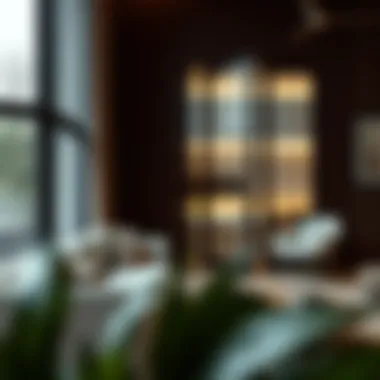

- Inspect Regularly: Routine inspections can help catch small cracks or chips before they escalate into more significant problems.
- Weather Stripping: Ensure that seals around doors are intact to minimize wind or moisture damage. This not only prevents dust invasion but also contributes to energy efficiency.
- Limit Heavy Use: Refrain from using glass doors as makeshift exits for heavy or sharp items, as they can lead to accidental scratches or worse.
- Educate Family members: Sometimes, it’s as simple as teaching those in your household about the importance of gentle usage. Little habits like closing a door carefully can prevent significant wear and tear.
In summary, the maintenance of glass doors is not just about aesthetic appeal; it’s a calculated effort that guards your home against future problems and retains its charm. By implementing effective cleaning strategies and taking preventive actions, you can ensure your glass showcases remain the shining stars of your modern interior.
Case Studies: Successful Integrations
Showcasing with glass doors is not just about aesthetics; it's about creating environments that elevate both function and style. By looking at case studies, we can gain valuable insights into how different spaces have successfully embraced glass doors to transform their visuals and functionality. These examples underline the significance of making informed design choices that blend seamlessly with a variety of settings. Each case provides a testament to the adaptability of glass doors, demonstrating their potential to serve unique needs while adding an air of sophistication.
Residential Spaces
A fine example of integrating glass doors in residential settings can be seen in modern townhouses, where space is often at a premium. In many of these homes, sliding glass doors have been installed to transition living areas to outdoor patios. This not only creates a fluid indoor-outdoor experience but also maximizes natural lighting. For instance, in a recent renovation of a 1950s era bungalow, the addition of floor-to-ceiling glass doors in the living room opened up the space to the garden outside. The homeowners noted that the once dark and cramped room now feels airy and expansive, creating a perfect atmosphere for hosting friends and family.
- Benefits:
- Brings in more light, reducing the need for artificial lighting.
- Creates an illusion of spaciousness without major structural changes.
- Enhances the property’s market value by modernizing aesthetics.
Commercial Environments
In commercial spaces, glass doors provide an opportunity to display products and create an enticing entrance. One notable case study involves a local coffee shop that utilized bi-fold glass doors to create a vibrant atmosphere. When opened, these doors not only invite guests inside but also enable the café to spill out onto the sidewalk, fostering a lively and welcoming environment. Patrons have remarked on how the bright, open layout encourages them to linger longer, increasing overall sales significantly.
- Considerations:
- Accessibility: Glass doors must be compliant with ADA standards to ensure ease of access.
- Branding: The design of the glass entrance can be customized with signage or etched logos, reinforcing brand identity.
- Safety: Decisions regarding tempered glass or laminated versions should not be overlooked to ensure durability and reduce potential risks.
"Incorporating glass doors into both residential and commercial settings redefines spaces by enhancing light and visibility, creating a sense of openness that is both inviting and sophisticated."
By studying these successful integrations, interior designers and homeowners can better appreciate the transformative power of glass. The ability to merge style with function can result in spaces that inspire both creativity and comfort. Whether for a cozy home or an energetic storefront, showcasing with glass doors means more than just a stylish choice; it's about crafting environments that resonate with users on multiple levels.
For further reading on the benefits and applications of glass doors, please visit Wikipedia on Glass Doors, or consider the insights shared by professionals at Interior Design.
Future Trends in Glass Door Design
The landscape of design is ever-evolving, especially when it comes to elements like glass doors. As homes become increasingly integrated with technology and sustainability becomes a priority, understanding the future trends in glass door design is crucial not just for homeowners, but also for interior designers, decorators, and realtors alike. These trends are set to redefine modern interiors, focusing on practicality, enjoyment, and an emphasis on personal style.
Innovations in Glass Technology
In the world of glass doors, innovation is moving at a breakneck pace. One significant trend is the advent of smart glass technology. This type of glass can change its opacity at the touch of a button, or even automatically based on the intensity of sunlight. It's not just about aesthetics; these innovations offer improved energy efficiency. By controlling how much sunlight enters a room, homeowners can cut down on cooling costs during those hot summer months, while keeping the space bright without compromising privacy.
Additionally, technology is enhancing safety and durability. Tempered and laminated glass options are becoming more popular, providing improved resistance to breakage compared to traditional glass. Such advances not only bolster the longevity of these features but also allowing for bolder designs without fear of compromising safety.
Integrating sliding and folding tech into design is another up-and-coming feature. Doors that can smoothly glide open with minimal effort, or bi-fold doors that can expand a space within the matter of seconds, are changing how we think about room transitions. This functionality melds seamlessly into open-plan living, allowing for a natural flow between spaces.
"The moves towards innovation in glass technology is poised to revolutionize not only energy efficiency but also how we experience our living spaces."
Sustainable Options in Glass Manufacturing
As the modern consumer becomes more conscientious of their environmental footprint, the demand for sustainable options in glass manufacturing is rising. Glass recycling initiatives are gaining traction, with manufacturers increasingly using recycled materials in their products. This not only lessens the impact on the environment but often results in aesthetic variations that can’t be achieved with new glass—giving each installation a unique touch.
Another noteworthy trend is the push towards producing energy-efficient glass. Technologies such as low-emissivity (Low-E) glass are designed to reflect heat while still allowing natural light through. This minimizes heat loss in colder months and reduces the load on heating systems, leading to lower energy bills and a more comfortable indoor environment year-round.
Also, eco-friendly sealants and adhesives used in the installation process are becoming commonplace. These materials are created with minimal harmful chemicals, ensuring that the installation process is as friendly to the environment as the product itself.
Incorporating these sustainable options is not just about being green; it’s also about adding value. Homes that feature sustainable design elements often appeal more to potential buyers, aligning with the growing trends of eco-conscious living.
By keeping abreast of these advancements in glass door design, stakeholders in the housing market can make informed choices that reflect contemporary values, ensuring that spaces are not only functional and beautiful but also responsible and future-ready.
Epilogue: The Lasting Impact of Glass Doors
In today’s fast-paced world, glass doors have emerged as a pivotal element in modern interior design. Their significance extends beyond mere aesthetics; they serve as functional and versatile installations that shape the atmosphere of a home or commercial space. In this article, we explored their role in creating visual continuity, enhancing natural light, and offering easy visibility of showcased items. Equally crucial are the practical benefits they provide, such as protection against dust for valuable items and seamless indoor-outdoor flow. Moreover, the right glass door choice can harmonize beautifully with existing decor, making it an essential consideration in design planning.
As we wrapped up the discussion, it became evident that these doors are not just a trend but a lasting staple in contemporary spaces. With the rise of innovative glass technologies and sustainable manufacturing options, their appeal will only grow in the years to come. The key takeaway is clear: integrating glass doors thoughtfully can transform an average interior into a remarkable experience, elevating both form and function seamlessly.
Summarizing Key Points
- Versatility: Glass doors can suit a range of styles, from modern to traditional, and can be tailored for various spatial applications.
- Aesthetic and Functional Benefits: They create a more open and inviting ambience, making small spaces feel larger and more connected to nature indoors.
- Maintenance and Durability: With appropriate care, glass doors can last for many years without significant wear, maintaining their clarity and appeal.
- Sustainability Trend: Innovations in glass production are leaning towards sustainable practices, appealing to environmentally conscious homeowners.
In essence, the diverse attributes of glass doors provide designers and homeowners alike with tools to create spaces that are as functional as they are pleasing to the eye.
Encouragement for Thoughtful Design Choices
In closing, it’s crucial to take a moment to consider the implications of every design decision, particularly when it comes to prominent elements like glass doors. Here are some elements to ponder when selecting glass doors for your space:
- Functionality: Will this door facilitate movement and enhance accessibility, or is it merely for visual show?
- Style Compatibility: Choose glass designs that complement existing furniture and colors. Consider your entire decor theme.
- Placement: An ideal spot can optimize natural light and room flow. Think through how open spaces can be effectively utilized.
- Safety and Maintenance: Understanding the materials used can inform you about durability and how to care for them.
"A well-considered choice in interior elements can drastically alter the vibe of your surroundings. Glass doors offer a unique blend of beauty and purpose; it’s up to you to make them shine."
In the vast landscape of interior design, the time is now to embrace the beauty and practicality of glass doors. Their potential is immeasurable; when thoughtfully integrated, they can lead to spaces that reflect individual style while enhancing both comfort and functionality.



